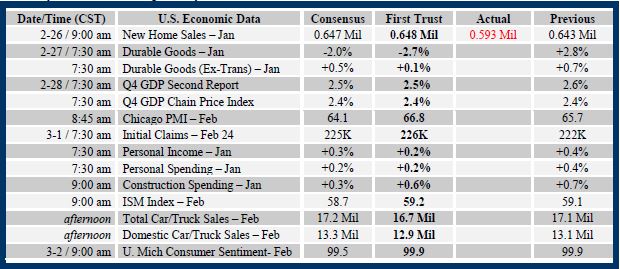Brian Wesbury Weekly Outlook
06.03.2018 15:20 - First Trust Global Portfolios Limited

Deficits, the Fed, and Rates
Forgive us our incredulity. The bond vigilantes were certain that as the Federal Reserve hiked short-term rates, long-term interest rates would barely budge, the yield curve would invert, and the economy would fall into recession.
That theory has been blown to smithereens, so now we hear that it’s rising long-term rates that will cause a recession.
According to the vigilantes, which ascribe deep meaning to every move in long-term interest rates, the U.S. has gone from secular stagnation and permanent low rates, to huge (impossible to fund) deficits and rising rates – overnight.
No wonder the average investor is completely confused.
So, let’s start at the beginning.
Yes, the Fed drove short-term interest rates to zero and held them there for seven years. And, yes, the Fed bought $3.5 trillion in bonds during Quantitative Easing. And, yes, the Fed is reversing course. It’s lifted the federal funds rate five times since 2015, and it’s slowly allowing its bond portfolio to shrink.
The federal government enacted tax cuts and spending increases, and the budget deficit ($665 billion in 2017) is now expected to approach $1 trillion or more in 2018 and beyond.
So, how much impact does each of these things have on interest rates?
Here’s our list:
1) If the budget deficit were no higher in 2018, than it was in 2017, long-term bond yields would still be higher today.
2) If the Fed had just lifted short-term interest rates, but had not started unwinding QE, longer-term bond yields would still be higher today.
3) When the Fed promises to hold short-term interest rates down, they pull longer-term rates down as well. Long-term rates (say a 5-year bond) are just a series of short-term rates (five 1-year bonds). So, rising 1-year yields mean rising 5-year yields.
When tax cuts and regulatory reform lead to stronger economic growth, a pick up in the velocity of money, and rising inflationary pressures, the bond market begins to realize that short-term interest rates need to rise – across the yield curve. Rising interest rates have everything to do with better economic data and nothing to do with QE and deficits.
Every dollar the government spends has to be paid for with either tax revenue or borrowing from bondholders. Either way, the money is “crowded-out.” If you pay higher taxes, but need to buy a machine, you have to borrow; if the government borrows the money first and doesn’t tax you, you still need to buy the machine. Either way, debt is created. But, it’s not the debt itself that drives interest rates up or down.
So, what about the QE-unwind? At this point, the Fed is only reducing its holdings of Treasury debt by $12 billion per month, versus a total pool of publicly-held Treasury debt of $14.8 trillion. A drop in the bucket.
Interest rates are determined by fundamental factors, not who owns what, or how many, bonds. Right now, fundamental factors in the US – faster growth, rising inflation and a tightening Fed – are pushing yields up….not deficits. In other words, the Vigilantes may think they have us on the run, but they’re not close to being dangerous.
Brian S. Wesbury - Chief Economist
Robert Stein, CFA – Deputy Chief Economist
